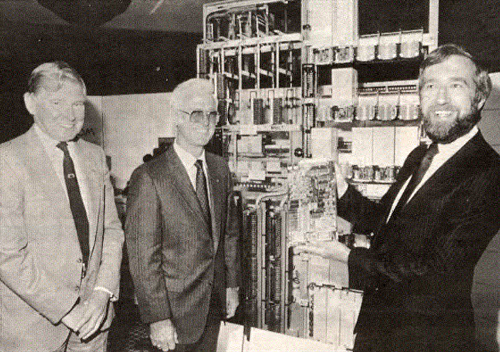 |
|
In 1891, Almon B. Strowger patented a system of automatic switching which contained the simple idea of 2-motion selectors for establishing calls between two subscribers. The Strowger switch design was so fundamental that it soon become the backbone of the World's telecommunications network for the next 100 years. The step by step system was used in the smallest villages right up to the largest cities.
Strowger was born in 1839 in Penfield near Rochester, New York and died in St. Petersburg, Florida, in 1902. He was 63.
History Takes A Hand [ Telecom Today October 1988 ]
THE great-grandson of the man who invented the automatic telephone exchange opened a computerised one which is British Telecom's answer to competition in an Enterprise Zone containing 24 international companies. Bob Doan - whose great-grandfather Almon B. Strowger designed the exchange system which took his name, in Kansas in 1889 - made a special trip from the USA to Telford, Shropshire. The digital exchange at Hollinswood-part of £7,400,000 investment by BT over the next five years - will serve businesses in central Telford. Mr Doan presented the Strowger exchange, which the new one replaced, to the nearby Ironbridge Gorge Museum.
North Wales and the Marches District General Manager Mike Marsden said: "This area is known not only for its forward-looking commercial and industrial development, but also for its pride in its industrial heritage and the allied benefits of tourism. In the same way that the canals and railways were the highways of the Industrial Revolution, so too, are telecommunications networks the highways of the information technology revolution. The basic switching technology that we have used until now is almost 100 years old, but the system invented by Almon Strowger still forms a significant part of the networks in use in most parts of the world."
It was, therefore, fitting that Mr Doan should have flown in from Texas to present the Strowger exchange to the museum where it would continue to give service and enjoyment and take its place along with many other "engines of change."
After the ceremony, the audience, which included local business leaders, saw a demonstration of high speed switching over the digital network.
Memories of the inventor...
RESEARCH by District Press and Broadcasting Manager Dewi Davies and by Telecom Technology Showcase in London led to the arrival in Telford of Bob Doan. Mr Doan, 60, who was accompanied by his wife Barbara, retired as a general manager with the General Telephone Company, and is now President of the Chamber of Commerce in Irving, Texas. Mr Doan inherited his knowledge of his ancestor from his grandmother Mary- Strowger's second daughter.
"A travelling salesman called Joseph Harris heard about great grandfather's invention and wanted to put it in the Chicago World Fair in 1893." he told Telecom Today. "When they installed the 99-line first automatic exchange at La Porte, Indiana in 1892, I don't think they recognised the impact it had. They spent about $1,000 on each of the four original switches, borrowed three telephones from friends and made a push-button which caused the system to function. My great grandfather and Harris formed a corporation to set up the first exchange, but they were not able to raise capital and went out of business. With that my great grandfather went into the building trade. I think he was more of an entrepreneur than an inventor. He became an inventor because of his desire to see that the customer had a choice."
All logos and trade marks are the property of their respective owners and are used on the Light Straw site(s) for review only. Students and researchers are recommended to make their own independent enquiries as to the accuracy of the information contained therein.